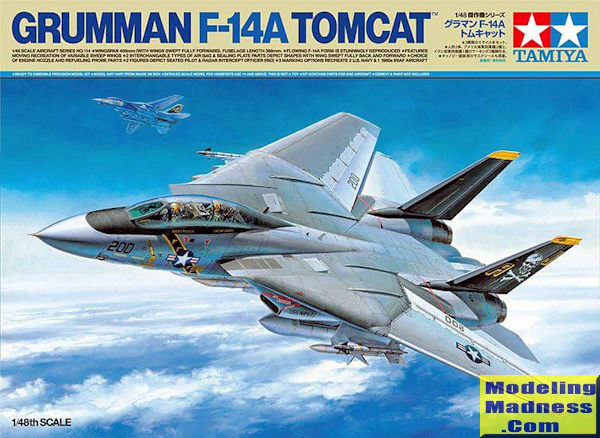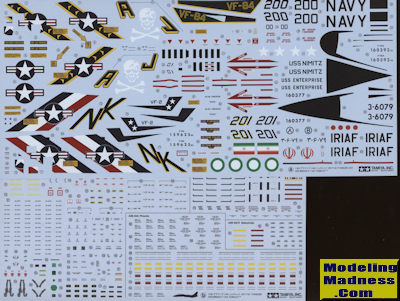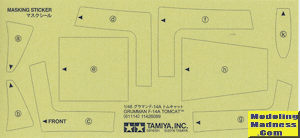
Tamiya 1/48 F-14A Tomcat
| KIT #: | 61114 |
| PRICE: | $6600 yen (About $60 at today's exchange rate) |
| DECALS: | Three options |
| REVIEWER: | Scott Van Aken |
| NOTES: | New tool kit |

| HISTORY |
The Grumman F-14 Tomcat is a supersonic, twinjet, two-seat, variable-sweep wing fighter aircraft. The Tomcat was developed for the United States Navy's Naval Fighter Experimental (VFX) program following the collapse of the F-111B project. The F-14 was the first of the American teen-series fighters which were designed incorporating the experience of air combat against MiG fighters during the Vietnam War.
The F-14 first flew in December 1970 and made its first deployment in 1974 with the U.S. Navy aboard USS Enterprise (CVN-65), replacing the McDonnell Douglas F-4 Phantom II. The F-14 served as the U.S. Navy's primary maritime air superiority fighter, fleet defense interceptor and tactical reconnaissance platform. In the 1990s, it added the Low Altitude Navigation and Targeting Infrared for Night (LANTIRN) pod system and began performing precision ground-attack missions.
The Tomcat was retired from the U.S. Navy's active fleet on 22 September 2006, having been supplanted by the Boeing F/A-18E/F Super Hornet. As of 2012, the F-14 was only in service with the Islamic Republic of Iran Air Force, having been exported to Iran in 1976, when the U.S. had amicable diplomatic relations with Iran.
It is amazing that the Tomcat was replaced by an aircraft that was more expensive and less capable, simply to accommodate politicians who wanted the supposedly unlimited barrel of weapons procurement money to flow into their states. Like the current over-cost, under-performing debacle with the F-35, the F-18 also took a rather rough road to operational status and even the highly modified F-18F, which supposedly replaced the F-14D, still does not have the capabilities of the F-14D. It is less agile, slower, has a shorter range missile system, and is unable to match the range of the F-14 without refueling.
| THE KIT |
When Tamiya announced that they were doing an F-14 in 1/48 scale, it generated a lot of excitement. Previous kits in this scale have been, well, less than easy to assemble. It was hoped that this one would be different. After all Tamiya has a reputation for excellent engineering and their more modern kits have proven that out to some extent. The builder still has to be careful during construction (as I found out with a recent F-16C build) and one does have to preplan things a bit, but much is expected.
This is basically your early F-14A. I'm sure that Tomcat boffins can be more exact, but Tamiya has certainly created a kit with growth as there are quite a few inserts. Starting with the cockpit you have a full tub with separate pieces for each of the four side consoles. Instrument panels also are made up of several pieces. In front of each side console is another small console that fits below the panels. The pilot has a control stick and rudder pedals while the guy in back has a control stick for the radar system. The rear bulkhead has separate circuit breaker panels for each side and above the side consoles are separate panels to simulate what is on the inside of the fuselage. The anti-glare panels for the instrument panels and the ejection seats are not installed until near the end of the build.
Since the cockpit sits atop the nose gear well, that is the next item to be built up. This is also not a simple construct. I like that only the main gear attachment point is installed at this time, allowing the nose gear to be glued on much later. The nose halves have several small panels and pieces to glue in place before closing up, including the large panel for the gun and vents. Once the nose is closed a piece to which the canopy attaches is then installed. On the forward bottom is another panel in front of the nose gear well that gets attached.
Next, the wing box is build up. This is just the center section and like most other 1/48 F-14s, the wings can swivel back and forth. One does not attach the actual wings until much later. Instead, there is a stub section that is held in place with screws and that includes a large T shaped piece which holds this all in place.
Moving to the lower fuselage, one assembles the intakes and ramps. One also has to open holes for the centerline weapons so you really need to know your weapons load early in the build. Each of the forward main gear wells is made of four interlocking wall sections. There are a few other inserts to deal with and then while that is drying, the forward and aft upper fuselage sections are joined, then attached to the lower section.
Tamiya provides full intakes back to the first compressor stage. These then fit into the lower fuselage section. You have to decide whether you are going to use the intake mounted fuel tanks prior to this. Frankly, this is probably the most troublesome area in other F-14 kits and it will be interesting to see how this fits. The nose is now attached as well as a large insert that goes on the lower fuselage.
Exhaust and the rear fuselage insert are next. Tamiya caught on to the fact that when the engines are shut down, one burner can is full open and the other fully closed. The wings do not have separate flaps and slats and simply slide onto the wing stubs when assembled. The next several steps are for building up the landing gear and attaching the doors. There are a lot of pieces involved in this so again, one has to take it slowly. I should mention that only the small seeker pod is located under the nose. Horizontal stabs are upper and lower pieces with the leading and trailing edges molded into the upper piece. If you opened the right holes, you can then install the missile pylons of your choice.
The rest of the build is assembling the weapons, attaching the fins, building up the seats and pilot as well as attaching the instrument panel anti-glare panels. There are no belts molded onto the seats, but for those who do not want to use crew, decals are provided. One can have the boarding ladder and steps extended and the canopy has very nice detail on the inside in terms of the catches that are frequently left up to p.e. makers to provide. One can also model the refueling probe extended or retracted. In the last years of the Tomcat's life, the probe door was often left off and that is an option as well. I doubt if that would be applicable to this kit's markings. Lastly the canopy can be posed open.
 Now, for
those who want to swing the wings, there are glove vane inserts and those
sealing bags for the back of the wing. Two different styles are provided, one
for forward and one for aft. These ae not to be glued in if you plan on
switching back and forth. Most of us will not want to use up all the shelf space
for forward swept wings and will leave them permanently in oversweep as they are
on the deck.
Now, for
those who want to swing the wings, there are glove vane inserts and those
sealing bags for the back of the wing. Two different styles are provided, one
for forward and one for aft. These ae not to be glued in if you plan on
switching back and forth. Most of us will not want to use up all the shelf space
for forward swept wings and will leave them permanently in oversweep as they are
on the deck.
Instructions are a 24 page
booklet with 45 steps. This includes three pages of stencil info rmation.
Markings are for three planes. One is the box art plane from VF-84. Can't have a
Tomcat kit without the Jolly Rogers. The other is a VF-2 plane. Both are in
gloss light gull grey over gloss white. The third is a desert scheme plane from
the Iranian Air Force. The decal sheet is superbly printed and there is a
separate stencil sheet that includes the seat harness and CRT decals. Tamiya has
also included a set of canopy masks so that is something many will welcome.
rmation.
Markings are for three planes. One is the box art plane from VF-84. Can't have a
Tomcat kit without the Jolly Rogers. The other is a VF-2 plane. Both are in
gloss light gull grey over gloss white. The third is a desert scheme plane from
the Iranian Air Force. The decal sheet is superbly printed and there is a
separate stencil sheet that includes the seat harness and CRT decals. Tamiya has
also included a set of canopy masks so that is something many will welcome.
| CONCLUSIONS |
For those who can get over the sticker shock ($115.00 SRP in the US), this one looks like it will fill the bill for those wanting a new 1/48 F-14. It certainly seems to have most of what people want and is so designed that we can be sure of other variants coming in the future. I am looking forward to giving this one a go.
| REFERENCES |
http://en.wikipedia.org/wiki/Grumman_F-14_Tomcat
November 2016
Thanks to me for the review kit.
If you would like your product reviewed fairly and fairly
quickly, please
contact
the editor
or see other details in the
Note to
Contributors.